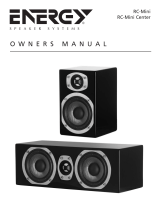
paradigm.com
5
To prevent damage to your speakers, please read the following
guidelines before making any connections.
Amplifier Distortion—The #1 Culprit!
Amplifier distortion is the principle cause of speaker damage. When
listening at higher volume levels, your amplifier may run out of clean
power and begin to produce a distorted signal if levels are increased any
further. This will damage any brand of speaker very quickly. (See your
Authorized Paradigm Dealer for amplifier recommendations).
More Powerful Amplifiers are Safer
When choosing an amplifier, always select an amplifier with a power
rating greater than that of the speaker. Using a 100W per channel
amplifier on a 50W speaker allows the amplifier adequate headroom in
order to provide a distortion free signal. Conversely, using a 40W per
channel amplifier on a 50W speaker limits the amplifier’s headroom. This
causes the amplifier to enter its distortion level much sooner, potentially
damaging the speaker.
Volume Control
Do not be fooled by the Volume Control of your receiver/preamplifier. It
only adjusts listening level—it is not a “power-output” dial. The amount of
amplifier power actually used at a given Volume Control setting depends
solely on the nature of the music you are listening to. At a given Volume
Control setting a quiet section of music will use less amplifier power than
a loud section. With typical pop-rock, jazz or large scale classical music
the rated output power of many receivers/amplifiers is often reached
when the Volume Control is between the “11” and “1” o’clock settings
(with bass/ treble and loudness controls not used—otherwise rated
power may be reached at even lower Volume Control settings).
Remember, all amplifiers produce distortion when operated beyond their
rated output power. The resulting distortion will damage all speakers!
Exercise caution! If you listen at loud levels, be careful to listen for the
point of audible distortion—if the speakers begin to sound distressed,
turn the Volume Control down or your speakers and/or amplifier(s) will
be damaged! This type of damage constitutes abuse and is not covered
by the warranty. If louder volumes are desired, obtain a more powerful
amplifier.
PREVENTING SPEAKER DAMAGE




















